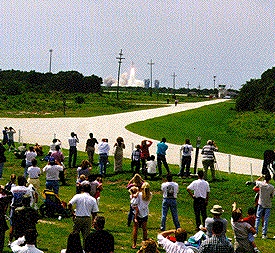
|
FUSE
|
Mission Status Report
|

Mission Status Report #9 Star Date: July 8, 1999
 Photo: FUSE soars up into the heavens aboard the Delta II rocket. (Photo: B-G Andersson)
Photo: FUSE soars up into the heavens aboard the Delta II rocket. (Photo: B-G Andersson)
(Click photo to see larger version.)
See more KSC Launch Day Photos.
Mission Status Reports on the web page will occur when news-worthy
events occur (but at least weekly!) for the time being.
-- Bill Blair
FUSE OPERATIONS TEAM ENCOUNTERS
FIRST GROWING PAINS
The FUSE satellite remains healthy and the In-Orbit Checkout phase is still in
progress. The Satellite Control Center at JHU is routinely in contact with the
spacecraft through the Puerto Rico and Hawaii ground stations, and occasionally
through TDRSS contacts. Thermal control has been thoroughly tested, with the
spectrograph ready for "bake-out" mode prior to reducing temperatures as we
approach normal operations.
The Ops team has been exercised by several issues, some of which are still being
worked at this writing. During the weekend, some anomalous behavior was detected
in the telemetry at several different times; careful analysis after the fact of
the timing of these incidents showed a direct correlation with passages through
the highest background regions of the South Atlantic Anomaly (SAA), a portion of
the orbit that intercepts the earth's radiation belts. Since this behavior have
not repeated on SAA passes since the weekend, it is hoped that these were "unlucky"
events, possibly related to the increased solar activity at that time, and not
an on-going problem. Still, analyzing such occurences with a new satellite takes
time and effort, and has helped to push the checkout behind our nominal pre-launch
schedule. On the plus side, the behavior of the Fine Error Sensor CCD cameras
in passing through the SAA has been characterized, and it looks like we should
be able to maintain tracking of guide stars without loss of lock.
Another area being worked involves the Attitude Control System (ACS).
The spacecraft uses a combination of onboard information and data uplinked from
the ground to understand exactly where it is in its orbit at any given time.
While this can nominally be calculated with accuracy, small changes in the orbit
parameters occur due to variations in atmospheric drag and other second-order
effects. If the ACS thinks the information it has and the information uplinked
from the ground are incompatible (over some threshold), it basically says "I
don't like this!" and puts the spacecraft into a "Safe Pointing Mode" until
ground controllers analyze the situation. Such an event happened over the holiday
weekend, and since this is the first such occurrence of the FUSE mission, it is
being thoroughly analyzed before we proceed. (Since the telescope doors are still
closed, there is no safety concern.)
Not all checkout activities involve specific spacecraft pointing orientation, and so
the ordering of checkout events has been shuffled somewhat to continue to make
forward progress. The planning team has responded well to these "replan" cycles,
and operations continue to run smoothly.
Over the next week, we hope to proceed to opening one telescope door and taking
our first test images of the sky with the FES guide camera. This will allow the
telescope focus to be assessed and permit our first attempts to actually guide on stars.
However, the FUV spectrograph detectors will still remain at low voltage until
the telescope structure has more time to outgas in the near-vacuum of space.
Reported by: Bill Blair, Chief of Mission Planning

| 

